History of Karate: 7 Ancient Weapons of Okinawa
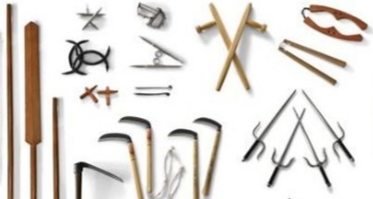
March 5, 2020
Kobudo, the ancient fighting arts, is a style of martial arts using weapons as the extension of the hand. Traditional Okinawan Kobudo originated in the Ryukyu Islands just south of Japan. When the Japanese military invaded the island of Okinawa, they confiscated all forms of weaponry, such as swords, spears, and bow and arrows. The inhabitants of the islands used ordinary farmer’s and fisherman’s equipment to use for self-defense, thus creating Kobudo. The seven main weapons of Kobudo is the Bo, Kama, Tonfa, Sai, Nunchaku, Eku Bo, and Tekko.
 The first weapon a Kobudo practitioner learns is the Bo (bō). The Bo, meaning staff, is a six-foot-long wooden dowel, typically tapered at the end. Its original purpose was to carry water buckets on each end by the shoulder. It could have also been the handle of a broom or mop. This is usually used as the first weapon to master because of its simplicity and practicality. It can be used just like your arms, with strikes acting like punches, and blocks being various arm blocks. A common misconception of the Bo is that it is commonly called Bo staff. Since Bo means staff, you are essentially calling it a Staff Staff.
The first weapon a Kobudo practitioner learns is the Bo (bō). The Bo, meaning staff, is a six-foot-long wooden dowel, typically tapered at the end. Its original purpose was to carry water buckets on each end by the shoulder. It could have also been the handle of a broom or mop. This is usually used as the first weapon to master because of its simplicity and practicality. It can be used just like your arms, with strikes acting like punches, and blocks being various arm blocks. A common misconception of the Bo is that it is commonly called Bo staff. Since Bo means staff, you are essentially calling it a Staff Staff.
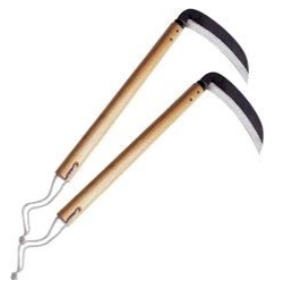
Next is the Kama (kah-mah). This sickle-like weapon was used by farmers for cutting rice. Later, it was used to cut paper. They are usually used with one in each hand, making it so you can attack with one hand, and defend with the other. It is one of the most dangerous weapons to use because it is very easy to get injured by wielding them. Some people have cut pieces of their ears off or have accidentally stabbed themselves! Most dojos require the wooden Kama for young students to use. Some Kama have ropes that slip onto your wrist so you don’t drop them. The rope can also be used to flip the Kama.
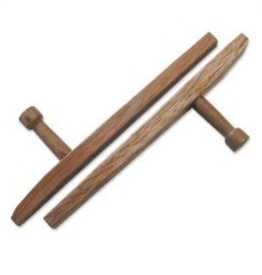
Next, the Tonfa (tōn-fah). The Tonfa is a wooden baton originally used for stone grinding. This weapon has become popularised by western culture because of its immense usefulness. Some American law enforcement agencies still use them to this day! The traditional Tonfa was specially designed to be past the elbow an inch or two. This lets the wielder block without concern of damaging the forearm. You can use the end of it to poke, and swing to strike.
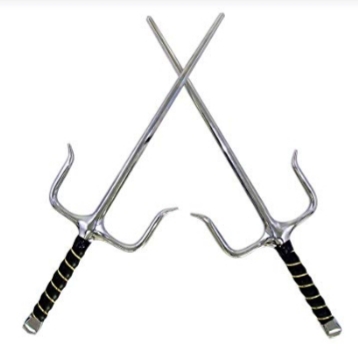
Another Okinawan weapon is the Sai (Seye). This dagger-like spear has one prong on either side to act as a guard. It is the most controversial weapon in Kobudo because people cannot agree on history. The most factual explanation is that it was found to be used for warfare in India and China. When it made it’s way to Okinawa, it was used by Monks to protect the temples. Other popular beliefs are it was used by police, used to spear fish, and used to help plant seeds into the ground. The Sai is another weapon that must be fitted to the user’s forearm past the elbow. Most believe the handguards were used for catching swords or bows and snapping them in half. It takes an immense amount of skill to accurately execute the purposes of this weapon.

The next Kobudo weapon is the Nunchaku (Nūn-cha-koo). The Nunchaku has a very simple design but is very hard to use. It may look like two sticks tied together, but proficiency is very hard to obtain. This weapon’s original purpose was to guide horses. You would put the string in the horse’s mouth and use the sticks to guide it. Contrary to popular belief, the Nunchaku is not called nunchucks. The word “Nun” means two, and “chaku” is a unit of measurement that roughly equals a foot. Therefore the name Nunchaku means two feet. It is normally used with only one pair, but two is occasionally used.
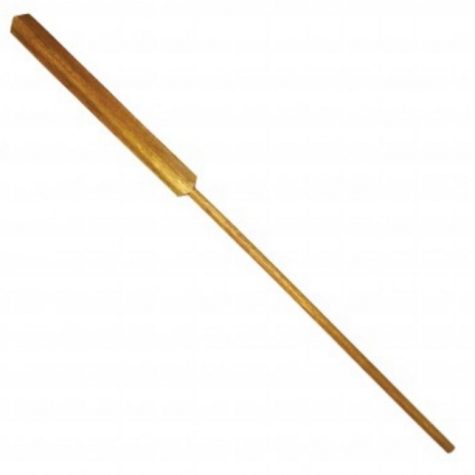
The following weapon is the Eku/Eiku bo (ay-koo-bō). The Eku bo was originally used by fishermen to row their fishing vessels. It is carved from wood in an oar shape. It is regarded as one of the most prestigious weapons amoung Kobudo practitioners because of its limited katas, a system of individual training exercises for practitioners of martial arts. There are only a handful of Eku katas that still exist today. The Eku bo has various means of offense. The wielder may poke with either end of the Eku bo. They could also strike with the blade and even dive the blade into the ground, and flick sand into the opponent’s eyes.

Finally, the Tekko (teh-kō). The Tekko are two U shaped horseshoes overlapping each other. It was originally just one horseshoe held in each hand, which later changed to be two overlapping for more power and speed. The westernized version of the Tekko looks like brass knuckles, but the ones mentioned previously are the traditional Okinawan version. it is one of the easiest weapons to conceal because of its small size.
For more information on Okinawan weapons, please watch the following videos:
https://youtu.be/VYIqbsdyY8g
There is currently only one martial arts center near New Castle that teaches traditional Kobudo. If you wish to learn the art of Kobudo, Karate-do, or Batto-do (swords), please visit Pennsylvania Shito-Ryu Karate-do Genbu-kai.
https://www.facebook.com/Genbu-kai-Karate-of-Pennsylvania-147872071983621/


Deanna Lynne • May 25, 2021 at 12:58 pm
Thanks for explaining the Kobudo staff, or Bo. My son is interested in learning Kobudo. I’m glad I learned about some of the weapons he’ll be using. http://www.tanakas-martial-arts-academy.com/